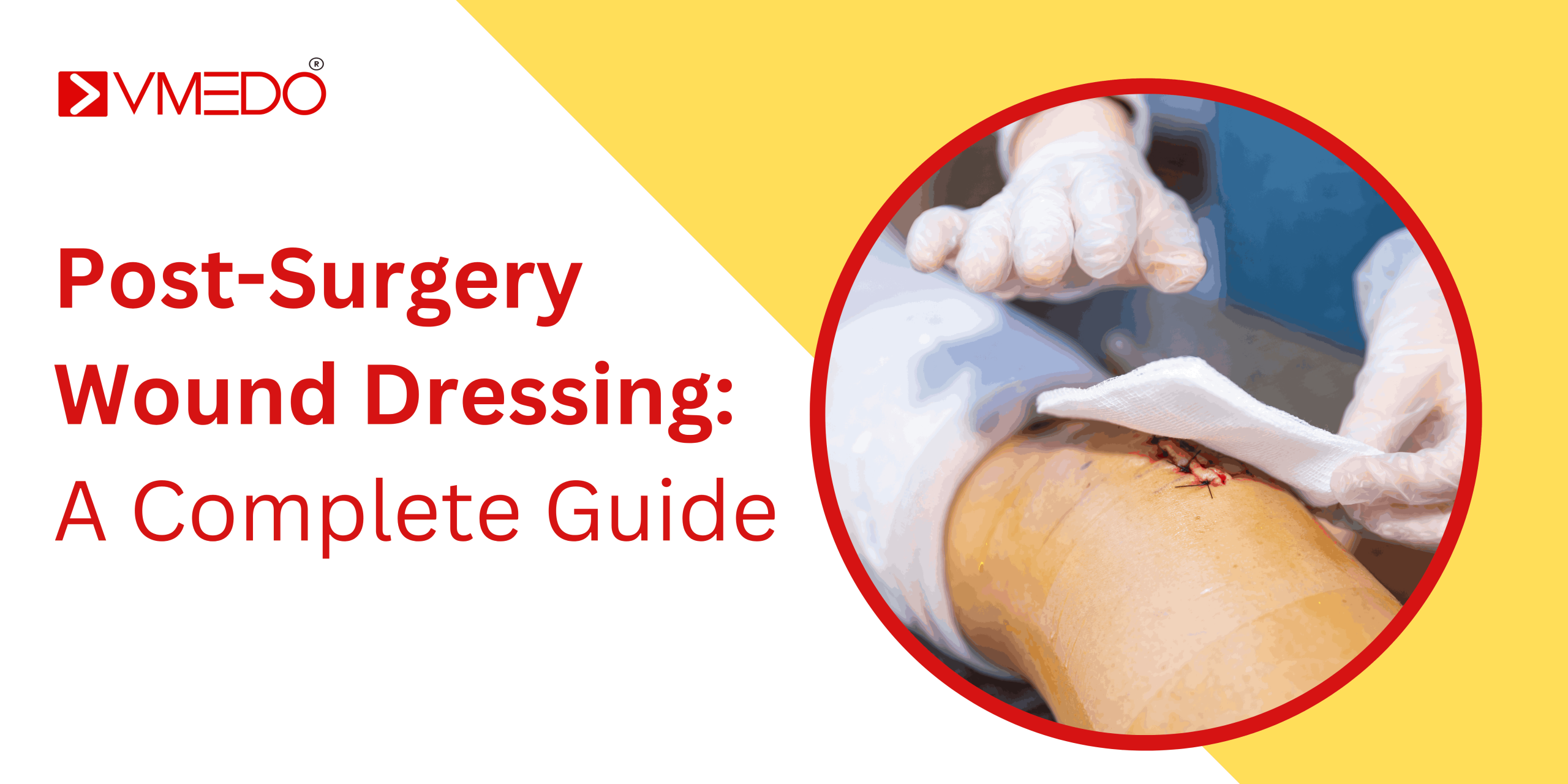Surgical wounds, though a part of the healing process, need proper care and attention to prevent complications such as infections, delayed healing, or scarring. Post-surgery wound dressing plays a crucial role in promoting faster recovery, minimizing discomfort, and ensuring patient safety. Whether it’s a minor outpatient procedure or major surgery, knowing how to take care of the wound is essential for patients and caregivers alike.
In this comprehensive guide by VMEDO, we’ll explore the importance, types, steps, precautions, and signs of complications associated with post-operative wound dressing — including when to seek professional medical help at home.
What Is a Post-Surgery Wound?
A post-surgery wound, also known as a surgical incision, is a cut made intentionally during surgery to access internal organs or tissues. After the procedure, this incision is typically closed with sutures (stitches), staples, or surgical glue. Though it may look healed on the outside, the internal layers need time and proper care to fully recover.
Why Is Wound Dressing Important After Surgery?
Wound dressing is more than just covering the surgical area. It serves multiple critical functions:
-
Protects the wound from infections
-
Absorbs excess exudate (fluid or pus)
-
Provides a moist environment for optimal healing
-
Prevents wound reopening or tearing
-
Reduces pain and inflammation
-
Monitors wound progress and complications
Types of Post-Surgical Wound Dressings
There are different types of dressings used depending on the wound type, location, moisture level, and surgeon’s recommendation:
1. Gauze Dressings
-
Made from cotton and used to absorb fluid.
-
Suitable for wounds with minimal to moderate drainage.
-
May require frequent changes.
2. Hydrocolloid Dressings
-
Contains gel-forming agents that keep the wound moist.
-
Best for clean, uninfected wounds with low to moderate exudate.
3. Foam Dressings
-
Highly absorbent and comfortable.
-
Ideal for wounds with heavy exudate.
4. Transparent Film Dressings
-
Thin and see-through adhesive films.
-
Allows monitoring of the wound without removal.
-
Used for superficial wounds with minimal discharge.
5. Antimicrobial Dressings
-
Contain antiseptics like silver, iodine, or honey.
-
Prevent or treat infected wounds.
How Often Should You Change a Post-Surgery Dressing?
-
Initially: Follow the surgeon’s instructions strictly. The first dressing is usually done at the hospital.
-
At Home: Change the dressing every 1–3 days or as recommended, especially if the dressing becomes wet, soiled, or loose.
-
After Healing Starts: Depending on the wound, the frequency may reduce as the healing progresses.
Step-by-Step Guide to Changing a Wound Dressing at Home
Here’s how patients or caregivers can safely change post-surgery dressings at home. Always consult a doctor or nurse before the first change.
Things You’ll Need:
-
Sterile gloves
-
Antiseptic solution (like Betadine or saline)
-
Cotton swabs or sterile gauze pads
-
New sterile dressing (as per type prescribed)
-
Adhesive tape or dressing bandage
-
Medical waste disposal bag
Step-by-Step Process:
-
Wash Your Hands Thoroughly
-
Use soap and water or a hand sanitizer before touching the wound.
-
-
Put on Sterile Gloves
-
Prevents contamination of both wound and dressing materials.
-
-
Remove the Old Dressing Gently
-
Peel off tape slowly.
-
Moisten with saline if the dressing sticks to the skin.
-
-
Observe the Wound
-
Check for signs of infection (redness, pus, odor, increased pain).
-
Note the color and amount of drainage.
-
-
Clean the Wound (If Advised)
-
Use prescribed antiseptic or saline solution.
-
Gently dab with cotton or sterile gauze. Do not rub.
-
-
Apply a New Dressing
-
Choose the right size and type of dressing.
-
Place it carefully to cover the wound completely.
-
-
Secure the Dressing
-
Use adhesive tape or bandage to keep it in place.
-
Ensure it’s snug but not too tight.
-
-
Dispose of Used Materials Safely
-
Place everything in a medical waste bag.
-
Wash hands again after the procedure.
-
What to Avoid During Wound Dressing
-
Do not touch the wound with bare hands.
-
Avoid using un-prescribed ointments or creams.
-
Don’t keep a wet or soaked dressing for long.
-
Never reuse dressings or cotton.
-
Do not expose the wound to water (bathing) unless permitted.
Signs of Wound Infection or Complications
Post-surgery infections can delay healing and become serious if ignored. Contact a healthcare provider immediately if you notice:
-
Redness or swelling spreading from the wound
-
Yellow, green, or foul-smelling discharge
-
Persistent pain or throbbing sensation
-
Fever or chills
-
Opening of the wound edges
-
Excessive bleeding
When to Call for Professional Help
Sometimes, dressing a wound at home might be challenging or risky — especially in the case of:
-
Elderly or bedridden patients
-
Diabetic patients (slower healing)
-
Deep or infected wounds
-
Post-orthopedic or abdominal surgeries
-
Individuals with limited mobility or vision
Tips for Faster Wound Healing After Surgery
- Keep the Wound Dry (Initially) – Avoid soaking in baths or pools until fully healed.
- Eat a Protein-Rich Diet – Helps tissue repair (eggs, lean meat, beans).
- Stay Hydrated – Water helps maintain skin elasticity.
- Avoid Smoking & Alcohol – They slow down healing.
- Don’t Scratch or Pick Scabs – Let the wound heal naturally.
- Follow Up with Your Doctor – Attend all post-op check-ups.
When Can You Stop Using a Dressing?
Most surgical wounds can go without a dressing once:
The wound is fully closed.
There’s no drainage.
The doctor confirms it’s safe.
Benefits of VMEDO Home Wound Dressing:
-
Hassle-free service at your convenience
-
Infection control by trained experts
-
Use of sterile and medically approved materials
-
Monitoring and reporting of wound healing progress
-
Affordable and quick booking process
Frequently Asked Questions (FAQs) on Post-Surgery Wound Dressing
1. Can I shower with a surgical dressing on?
Not unless your doctor allows it. Some waterproof dressings may permit light showering, but always keep the wound dry and protected.
2. Is pain normal during dressing change?
Mild discomfort is common, especially early on. If pain is severe, consult your doctor.
3. How long does a surgical wound take to heal?
It depends on the type of surgery and individual factors. On average, skin closure takes 7–14 days, while internal healing may take weeks.
4. Can I do wound dressing at home myself?
If it’s a simple, clean wound and your doctor approves, yes. Otherwise, seek help from a nurse or medical professional.



